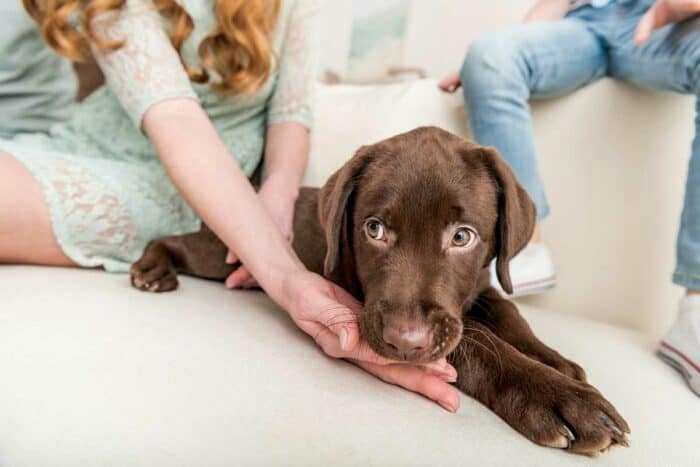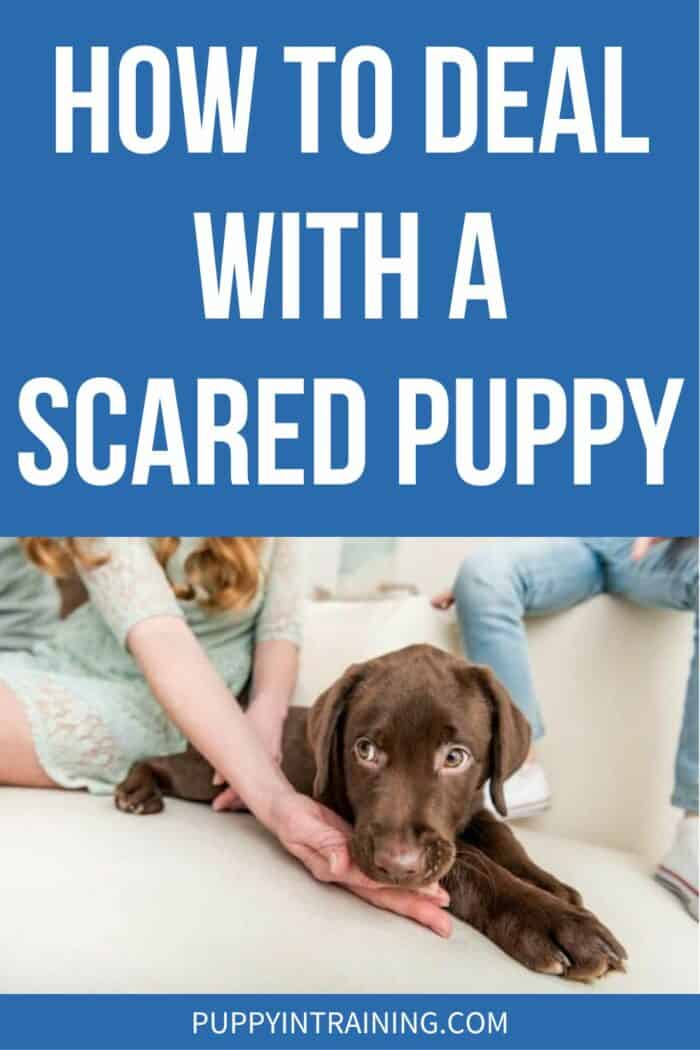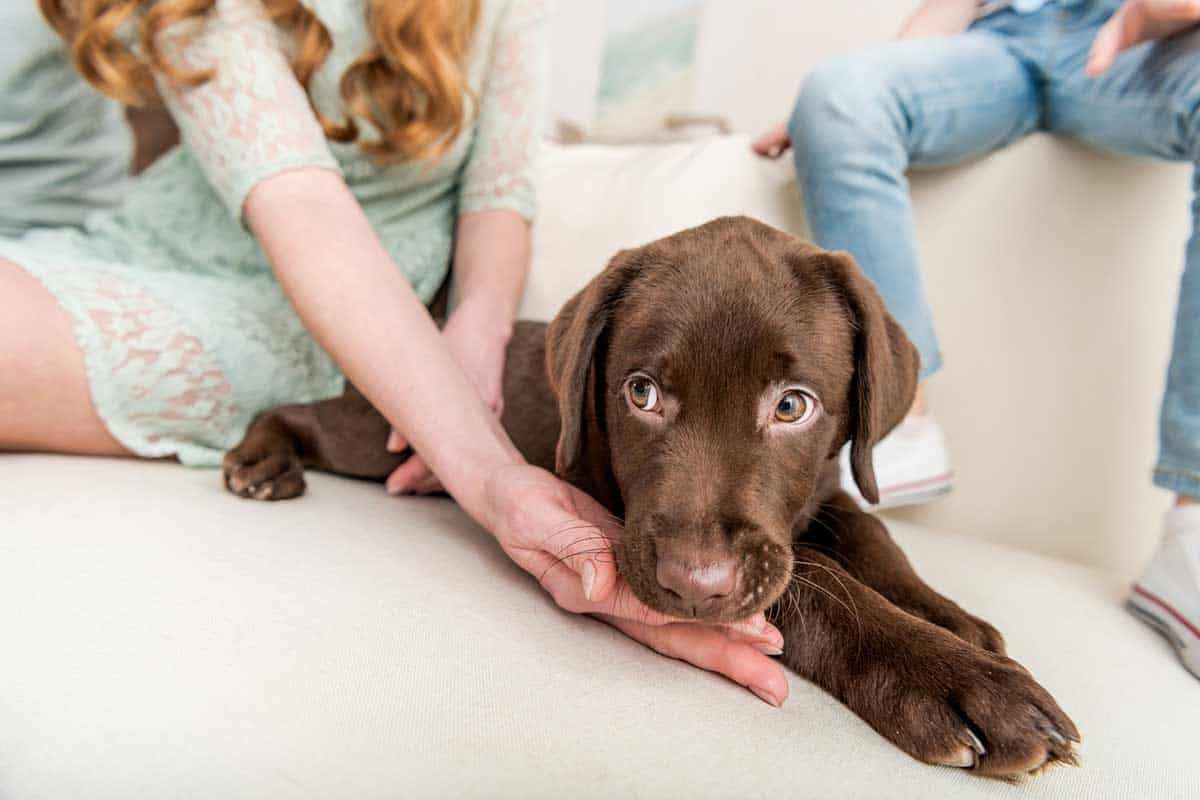This post may contain affiliate links. We may earn money or products from the companies mentioned in this post.
As puppies grow up, they go through many different developmental stages.
Unfortunately, it just so happens that some of these stages are based around fear, which can lead to you having a very scared puppy at home.
Many new puppy owners are left wondering how on earth their rambunctious little pup went from being the life of the party to being scared of their own food bowl within a single week.
This is a completely normal thing to happen, though; you have done nothing wrong!
Puppies tend to go through two fear periods in their lives where they become very wary of their surroundings and fearful of new experiences and objects.
They can also develop a sudden fear of old experiences and objects, too, which can be exhausting and worrisome for new owners.

In this article, I will detail what you can expect during these two fear periods as well as what you can do to ease your scared puppy through them!
When To Bring Your New Puppy Home
Interestingly, there are right and wrong times to bring a puppy home. The earliest you should bring a puppy home is at the 8 week mark.
At this point, most puppies are able to live without their mother and are starting to explore the world on their own.
To have a more detailed look at the stages of puppy development and why the 8 week mark is so important, check out my guide on when puppies can leave their moms.
It just so happens that the time to bring your puppy home often coincides with the beginning of their first fear period. Thankfully, there are some things you can do to make the process as ‘unscary’ as possible for your poor pup.
Use a small room or a play pen to reduce the size of the area they are first introduced to. This reduces the smells, the noise, the textures, and the sounds they are exposed to at any given time.
This is a crucial stage of development for your puppy, and you cannot simply leave them in the pen or room at all times.
Every day, take them out of their room or pen and introduce them to other areas of the home, other members of the family, and other pets you may have. This will lower the chance of them entering the fear period in your home if they have not already.
It is important, and often tricky, to walk the fine line between giving them a safe, familiar place (like a room, play pen, or crate) to retire to while also socializing them effectively at the same time.
What Are Fear Periods?
In the developmental stages of puppyhood, pups go through two fear periods: the first at 8 to 11 weeks and the second at 6 to 14 months.
Unfortunately, you cannot prevent your puppy from entering into their fear periods with good training, a calm environment, or excellent care.
A fear period will happen (or it won’t), and it is dependent entirely on the individual pup and not on what you did or didn’t do for them.
Let’s take a closer look below at what each fear period will be like for your fearful puppy.
Fear Period 1 (8 To 11 Weeks Old)
At 6 to 8 weeks old, a puppy starts becoming very interested in the world around them and will explore as much as they can. However, the world is very large, and they are very small. Even for a large dog breed puppy, the world feels incredibly big.
Your puppy will be at war with itself over its need to explore life while being scared of big objects, loud noises, and things that move quickly, like children, cars, cleaning implements, or other animals.
During this first fear period, allow your scared puppy to explore their surroundings, meet new people, and start to socialize with other animals in a calm environment. You will need to do this slowly to not overwhelm them.
Always let them retreat to their safe space when they want to, and don’t pressure them into interacting when they are scared.
Fear Period 2 (6 To 14 Months Old)
The second fear period can also cause a new puppy owner some alarm and stress.
Your puppy has been socializing, developing new habits and interests, playing to their heart’s content, and now, all of a sudden, they wont go near their food bowl, run away when a friend comes for a visit, or bark and cry when you vacuum.
A year-old puppy looks an awful lot like an adult dog, and you may be used to treating them in such a way. However, they are still young and in one of their final emotional development stages.
Your normally confident and outgoing puppy will suddenly become fearful and insecure of an environment they are used to, toys they love, and experiences they once cherished.
This can be seen as an awkward teenage/puppy phase where the world they loved becomes very scary again.
Thankfully, this fearful behavior doesn’t last forever, and (provided they are trained through the period and cared for) your pup will not suffer lasting effects from their newfound fears.
Persevere, and your pup will bounce back eventually!
Training Your Scared Puppy Through Their Fear Periods
During the times when your puppy becomes scared or fearful of their surroundings, there are a few things you can do to help alleviate their fear and train them through these periods to help them develop into healthy adult dogs.
Socialization is essential. For a more in-depth look at what socialization is and how it helps your puppy, have a look at my article dedicated to the why’s of socializing your puppy and my article dedicated to the how’s of socializing your puppy.
Do not completely isolate your puppy if they are showing signs of fear. Allow them to be alone when they want to be, but keep socializing them everyday with other people and with other animals.
Step-By-Step Training Of Fearful Puppies
While training your puppy during their fear periods, here are some detailed steps to follow to make the process easier on both you and your new pet.
- Provide your puppy with a safe ‘run-away’ space they can go to when stressed.
- Identify what your puppy is afraid of specifically and don’t make a big deal of it; instead, try to bring it into future training sessions and make it seem like an ordinary object
- Don’t force them to maintain contact with the person/object causing them to be scared.
- When your puppy explores the thing that is making them afraid or goes just a step or two closer, praise them with kind words and treats.
- Don’t punish them for running, uncontrollably wetting themselves, or barking at what is making them scared.
- Don’t overwhelm your puppy with physical affection or pressure them into getting closer to what is making them scared.
- Keep these training sessions short and sweet; 20 minutes three to four times per day is the maximum time they should be in training.
- Always end on a positive note with treats and praise.
Your puppy may snap out of their fear period quickly, or they may take a long time to get back to normal. Keep up with their training to help ease some of their stress.
REAL WORLD EXPERIENCE: Our current puppy, Anna one day decided she was scared of toys floating in the swimming pool. We never forced her to do anything. We let her approach them at her own pace. We told her good girl as she stepped closer. Eventually she decided there was nothing to fear.
What Do Puppies Become Afraid Of During Fear Periods?
While each puppy is scared of different things during their fear periods, there are a couple of things that will get a fear response out of almost any puppy:
- Children
- Loud noises
- New places with lots of smells
- New people
Interestingly, these are the same things that get a fear response out of most human babies and toddlers, too.
Think whether the object you are bringing home or the experience you are about to introduce will frighten or stress a baby or a puppy.
If the answer to either one is a yes, then a very slow introduction is necessary.
FAQs About Scared Puppies
How do I know when my puppy is scared and when they are playing?
It’s important to know how to read your pup’s body language because this is how they communicate to you.
Carefully examining the position of their tail, ears, head, and muzzle will help you know whether your puppy is playing around with you by crawling under furniture or if they are hiding away from something that has scared them.
Here are some of the most common indicators that your puppy is genuinely scared:
- Keeping their body low to the ground with their head down
- Ears tucked back
- Tail tucked underneath their body
- Hair standing up along their spine
- Trembling
- Constantly rolling over and showing their belly and throat while whining or shaking
- Sudden heavy panting
- Constant barking
- Baring their teeth and wrinkling their muzzle
- Moving in slow motion
- Rolling their eyes or showing the whites of their eyes
Why is it so important to maintain a trauma-free environment during a puppy’s fear period?
The fear periods are crucial stages of development for puppies.
If there is a trauma that happens during a puppy’s fear stage and careful training is not applied afterwards, it could leave a lasting impact on the puppy, which will translate into altered behavior when they grow up.
Let’s have a look at a couple of examples of how traumas during the fear periods may impact adult behavior:
Small traumas that seem insignificant can make a great deal of difference when your tiny pup turns into a full-grown dog. This is why it’s so important to continue careful training throughout their fear periods.
Am I a failure if my puppy goes through both fear periods?
A fear period is an evolutionary training mechanism that teaches a puppy when they need to be cautious and when they need to be bold, not all foods are safe to eat, not all animals are safe to play with, and not all holes are safe to explore.
All puppies are unique, and some of them only go through one of the two fear periods. However, it is important not to feel discouraged or like a failure if your puppy does go through both periods because it is 100% normal and expected for all dog breeds.
It often has nothing to do with you and your home and everything to do with how your puppy’s brain works. It is important to go through these periods with confidence and ensure your pup’s training stays consistent and gentle.
Unfortunately, some people find these periods too difficult or feel like their puppy is ‘defective’ and give up, leading them to either abandon the puppy or surrender it to authorities.
Wagging Away On Scared Puppies…
We never want to see our puppies scared of anything. However, fear is how evolution has kept them safe from venturing out into a world that could harm them.
Pups will go through two fear periods where they are scared of things that were once familiar and exciting.
Keep these three things in mind while your puppy goes through their fear periods:
- Reward them with treats and praise often
- Don’t overwhelm them or pressure them into approaching what they are afraid of
- Try to specifically identify what your puppy is afraid of
During these periods, it is important to keep up with their training and maintain a calm, stress-free environment with them to ensure healthy emotional and behavioral development.
Fear doesn’t last forever, but your love for your puppy will!
Save To Pinterest

Top Picks For Our Puppies
- BEST PUPPY TOY
We Like: Calmeroos Puppy Toy w/ Heartbeat and Heat Packs – Perfect for new puppies. Helps ease anxiety in their new home. - BEST DOG CHEW
We Like: Bones & Chews Bully Sticks – All of our puppies love to bite, nip, and chew. We love using Bully Sticks to help divert these unwanted behaviors. - BEST DOG TREATS
We Like: Crazy Dog Train-Me Treats – We use these as our high-value treats for our guide dog puppies. - BEST FRESH DOG FOOD
We Like: The Farmer’s Dog – A couple months ago we started feeding Raven fresh dog food and she loves it! Get 50% off your first order of The Farmer’s Dog.
Check out more of our favorites on our New Puppy Checklist.




